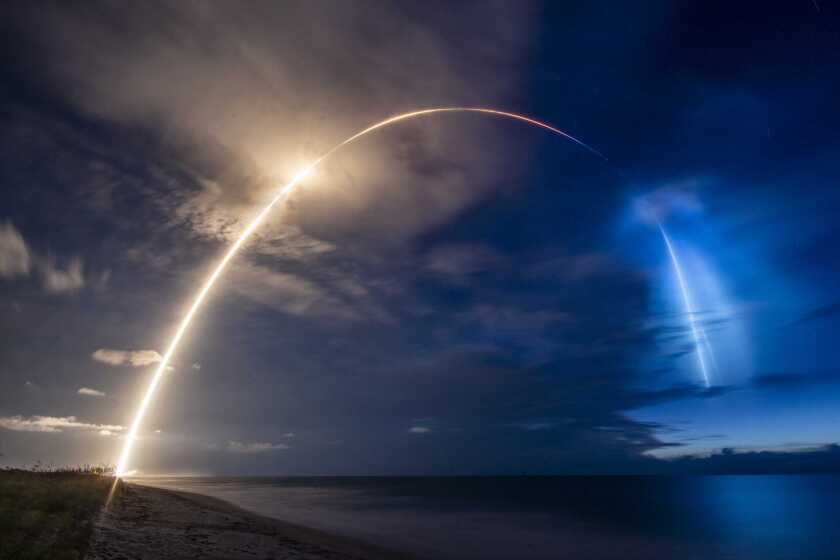It says something about the – what’s the polite word? – challenging state of the satellite industry when at least two of its major companies are in bankruptcy protection.
There’s OneWeb, a brilliant idea of French aerospace company Airbus to put small satellites in low Earth orbit (LEO) in order to create a low-latency worldwide broadband delivery system.
And there’s the granddaddy of them all, Intelsat, almost old enough to draw its pension, with its geostationary (GEO, as they’re now called) satellites hovering above the equator. They were marvellous when they went into service, bringing live TV not just around the world but also from the Sea of Tranquillity in July 1969.
OneWeb filed for bankruptcy protection in the US in late March, citing the Coronavirus as the cause, despite its backing from companies such as Airtel, Airbus and SoftBank. It has launched 74 satellites but said that the Covid-19 pandemic was causing turbulence in the market.
Intelsat filed for bankruptcy protection in May, in a move apparently designed to allow it to benefit from a refarming of spectrum in the US.
The company said that Intelsat General, the subsidiary that serves commercial and government customers in the US, and military customers, was not affected. And it said that “operations and capital investments will continue as usual during the process”.
CEO Steve Spengler said in May: “Our success has come despite being burdened in recent years by substantial legacy debt. Now is the time to change that.”
But the company had had a torrid time on the New York Stock Exchange, where its shares have been quoted since April 2013. On the eve of its filing for bankruptcy protection, its shares closed at US$0.79, valuing the company at just $112 million. Only six months before shares were trading at $26.33, and in October 2018 they were $34.61.
Curiously, three years ago OneWeb considered buying Intelsat, but it withdrew after the two companies failed to strike a deal with debtholders over existing Intelsat bonds believed to be worth around $15 billion.
No wonder that satellite analysis company Northern Sky Research (NSR) believes the industry’s revenues will go down by 7% and will take more than three years to go back to last year’s levels. NSR agrees with OneWeb’s assertion that the fall is the result of the Covid-19 pandemic, “and the recovery won’t be immediate”.
But there will be a recovery, says NSR’s analyst Lluc Palerm. “The underlying opportunity continues to be exceptional with revenues forecasted to grow at double-digit rates in the 2023-2029 period.”
Meanwhile the UK – not the US – cavalry has ridden to the rescue of OneWeb, with Alok Sharma, the British government’s Secretary of State for Business, Energy and Industrial Strategy (BEIS), in the role of General Custer – carrying, not an overwhelming force of arms against defenceless people, but $500 million of UK taxpayers’ money.
Sharma was joined by Indian telecoms entrepreneur Sunil Bharti Mittal, who also handed over $500 million of Bharti Enterprises’ money. They were later joined by Charlie Ergen, owner – via EchoStar – of Hughes Network Systems, with an extra $50 million.
Sharma’s decision was opposed by the civil servant who headed his BEIS department. She wrote: “There was insufficient time to make a full assessment of the proposed investment and enough uncertainty around the potential return for the UK that meant it was not possible for me to assure Parliament that the investment represents value for money to the standards expected by managing public money.”
The committee of back-bench legislators also questioned the decision. Darren Jones MP said this “heightens concerns around this investment and about the prospects of this delivering UK jobs and value for taxpayers’ money”. Jones is probably right to be wary: OneWeb has a shiny new factory in Florida, built at the cost of $85 million.
Debra Facktor, head of the division that is building the satellites, is determined that the production will stay in Florida, she said in an interview with Space News in July. The company she leads, OneWeb Satellites, is a 50-50 joint venture of OneWeb – the operator – and Airbus, the French company that is desperate for US government business. Whatever the UK government’s investment, OneWeb isn’t going to move its factory to the UK.
That’s the problem with the satellite industry. For 60 years it’s been part commercial but overwhelmingly military, political and nationalistic.
What’s happening is an epochal change in the industry. The old-style business was based on satellites orbiting 35,786km above the equator – the orbit identified in 1945 by engineer and science-fiction writer Arthur C Clarke as allowing satellites to appear to hover in fixed position.
That’s a long way, which means signals are weak. It also means there’s a round-trip of more than 70,000km out and another 70,000km for the reply, whether it’s voice or data. The speed of light, and radio waves, is a constant of the universe: that’s a built-in half-second delay.
That’s why the industry is now working hard on LEO and medium-orbit – MEO – satellites. They get the latency down to the levels that a signal anyway takes to get to a nearby data centre – a few milliseconds.
Elon Musk’s Space X is doing this, planning 42,000 in its Starlink constellation. So does Amazon, which is calling its service Kuiper: they’ll be around 600km high, like extra-long celltowers. And that’s what OneWeb is planning, should its rescue be successful.
But the satellites will be hurtling around the planet every two hours or so.
That means an end to the traditional fixed dishes – those on the wall of your house, pointing at DirecTV, Sky, or whatever your local satellite TV service is, or pointing at, for example, one of Intelsat’s powerful successors to the original Earlybird from the 1960s. Fortunately technology has caught up: there are now electronically steerable flat arrays that can follow the fast-moving satellites across the sky.
And, maybe, that’s why there’s a revival in optimism among the relatively small community of satellite people. They always have been an obsessively optimistic bunch of people, at least during the 35 years or so I’ve been following them: it’s hard to be otherwise if you are willing to put a traditional satellite, the result of a 10-year design effort, on top of a barely controlled bomb. Remember, until SpaceX, the technology used by virtually every rocket was a direct descendant of Hermann von Braun’s V2 from World War 2. They were bombs: they killed thousands of civilians, and even more civilians died in slave factories that built them.






